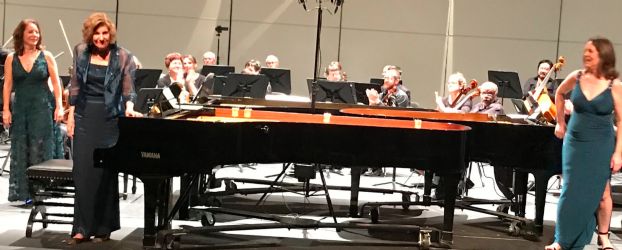|
Symphony
FROM THE NEW WORLD TO THE OLD WORLD
by Peter Lert
Saturday, June 14, 2025
Chamber
MC2 DUO RECITAL CLOSES 222'S SEASON
by Terry McNeill
Saturday, June 14, 2025
Choral and Vocal
CANTIAMO SONOMA'S LUSCIOUS A CAPELLA SINGING IN SEASON ENDING CONCERT
by Pamela Hicks Gailey
Sunday, June 8, 2025
Symphony
SRS SEASON ENDS WITH RESOUNDING TA-TA-TA-BANG
by Terry McNeill
Sunday, June 1, 2025
Symphony
YOUTHFUL VIRTUOSITY ON DISPLAY AT USO'S MAY CONCERTS
by Peter Lert
Saturday, May 17, 2025
Symphony
MYSTICAL PLANETS AND LIVELY GERSHWIN ORTIZ AT FINAL SRS CONCERT
by Peter Lert
Sunday, May 4, 2025
Symphony
VSO'S CONCERT MUSIC OF TIME, MUSIC OF PLACE
by Peter Lert
Sunday, April 27, 2025
VOCAL ELEGANCE AND FIRE AT THE 222'S RECITAL APRIL 26
by Pamela Hicks Gailey
Saturday, April 26, 2025
CANTIAMO SONOMA SINGS AN INSPIRED GOOD FRIDAY MOZART REQUIEM CONCERT
by Pamela Hicks Gailey
Friday, April 18, 2025
DRAMATIC SHOSTAKOVICH SYMPHONY CLOSES PHILHARMONIC'S 25TH SEASON
by Terry McNeill
Sunday, April 13, 2025
|
 |
 E. Casanova, C. Steinbuck and E. MacDougall Jan. 27 |
TRIPLE PLAY UKIAH SYMPHONY CONCERT AND TCHAIKOVSKY SERENADE
by Terry McNeill
Sunday, January 27, 2019
Over the years the Ukiah Symphony’s concerts have been in the Classical Sonoma Calendar sections, but rarely has this Orchestra, now in its 39th season, had a full winter season concert review. The provocative Jan. 27 program in Mendocino College’s Center Theater seemed a good reason to reacquaint readers with developments for Mendocino County’s premiere ensemble.
Developments have been good. Now in his 29th season, conductor Les Pfützenreuter led a unique pairing of two three-piano concertos, with Tchaikovsky’s Serenade for Strings occupying the concert’s first half. USO string sound is always iffy as small numbers of musicians (today 8 violins, 3 violas, 4 cellos and 2 basses) produce less than sonorous volume. Additionally intonation problems appear in fast ascending passages in the upper strings, and cutoffs were more crisp than attacks.
That said, Mr. Pfützenreuter had deft control of dynamics with subtle piano and pianissimo differences in the second movement waltz, coupled with steady rhythms and interpretatively little rubato. Viola playing had particular beauty with other string playing winding around them, and thematic restatements in the famous richly colored élégie were elegantly shaped by the conductor. If the initial and second themes in the élégie don’t tug at your heart strings, Tchaikovsky’s music probably isn’t for you.
Tempo in the finale was judicious and overall string sound lack depth, but Mr. Pfützenreuter’s ability to draw sounds swelling from pianissimo to mezzo forte was estimable. The Theater’s acoustics, warm but with negligible reverberation, underscored this captivating and passionate music.
Following intermission Bach’s D Minor Concerto (BWV 1063) for three keyboards was heard, followed by Mozart’s F Major “Triple” Piano Concerto, K. 242, were heard. The common instrument placement of parallel piano “noses” facing directly into the orchestra was dropped in favor of the flügel a flügel arrangement, with pianists Carolyn Steinbuck and Elena Casanova facing pianist Elizabeth MacDougall across instruments with their lids removed.
Each of the soloists has a long Mendocino County performance history and concerts with Mr. Pfützenreuter, so it was no surprise that the Bach from 1733 unfolded with graceful musical counterpoint. Pacing is critical in this work and the conductor kept a steady tempo that allowed the themes, from the primo (Ms. Steinbuck) and secondo (Ms. Casanova) parts, to emerge from what in lesser hands could have been cloudy sound. Playing in the siciliana was lovely and the fugal parts of the concluding allegro had a joyous character.
As good as the Bach work is, and it is very good, the Mozart has more heft and structural interest. The pianists did not rotate instrument positions, and after so much string music it was good to have additional instruments in the mix, especially the horns (though they were way to loud the entire piece). Ensemble was mostly good with a few spots that were rushed and out of sync, something the conductor has no way of fixing during a performance. Ms. Steinbuck played the short cadenza in the opening allegro. Oddly for a work with three solo pianos the most effective thematic statements belonged in the orchestra, and Mr. Pfützenreuter’s control was intensive, though accomplished with less forceful body movements than one sees with most other conductors. In the adagio some of the afternoon’s best playing was heard, the captivating dolce theme came from Ms. Steinbuck, with just the right tinge of sadness. The sonic pianistic interplay in this movement and the technically assured concluding rondo was a highlight, three “singers” at the service of beguiling music.
A standing ovation greeted the conclusion of the concerto, and the conductor spoke of his devotion to Mozart, and that the composer’s 263rd birthday was falling on the day of this concert.
Orchestra officials subsequently informed the packed hall that the May 18 and 19 concerts would be the final ones for the conductor, and a search had begun for a new music director. Mr. Pfützenreuter retired last year as Professor of Music at the College, and announced that he now has time to reacquaint himself with French horn technique.
|

